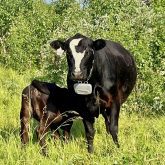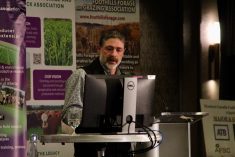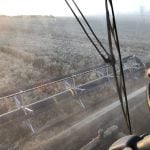I hope this title suggests that there is a definite causal link between grazing management and soil health. Nothing you do on grazing lands can improve soil health more than good grazing management.
While growing up, I wanted to be a rancher because I liked cattle and the challenge of raising them profitably. I wanted more grass only because it meant more cattle. My thinking didn’t get to cause and effect. Over the ensuing years I have changed my order of thinking from cattle, grass, soil (with little thought about soil) to soil, grass, cattle. Now I understand that all life comes from the soil.
Read Also

The Canadian Cattle Association’s international advocacy efforts
Global ag policies affect Canadian food policy, so the Canadian Cattle Association participates in international and domestic forums
A healthy soil provides for healthy plants; and healthy plants provide for healthy soil microbes, insects, birds, wild animals and domestic animals. Human health also improves when the foods people consume come from healthy soils.
Four ecosystem functions
There are four ecosystem functions which our grazing (or farming) management can help, improve or enhance, or our management can hinder, damage or diminish the effectiveness of these functions:
1. Water cycle. A highly efficient water cycle has very little runoff or evaporation. It infiltrates water into the soil which has very good moisture-holding capacity so that moisture is available for plant growth. Excess moisture can move laterally in the soil toward springs and streams or into the aquifer rather than ponding, pooling or running off.
2. Mineral cycle. An effective mineral cycle moves manure, urine, dead bugs, plant residues, etc., from the soil surface into the soil to feed soil microbes which in turn feed plants.
4. Succession or community dynamics. Any change in the first three functions will automatically trigger successional biological dynamics (compounding and cascading effects). If positive, biodiversity of all types will increase. New and different plants, insects, birds, soil organisms, etc., will appear. This all makes soil healthier. Remember, with poor management the opposite will occur.
Ecosystem health, soil health and biodiversity all hinge on what our management does to these functions. The effects of our grazing practices are never neutral. They are either positive or negative.
Well over half of the topsoil has been lost from most of the farmland in the U.S. (and probably Canada) since the time of European settlement. Think of the loss of biological capital, fertility, etc., that has gone to the rivers, lakes and oceans. This can be stopped, and soil can be rebuilt or regenerated much faster than previously thought.
Six soil health principles
There are six principles of soil health that, if understood and followed, will regenerate soils on any ranch anywhere. If your grazing (or farming) practices obey or adhere to these principles, the ecosystem functions will perform better and better and your soil will improve and be healthier and more productive.
The six principles of soil health are:
1. Know your context. What is your situation — strengths, weaknesses, climate, market, biodiversity, soil health, plant community, grazing practices, mindset, current understanding, finances, ranch enterprises, your vision and objectives, etc.
3. Armour or cover the soil. Maintaining cover on the soil surface will greatly reduce wind and water erosion. Cover will moderate soil temperatures and reduce evaporation. It improves moisture infiltration and retention in the soil so that more of the rainfall and snowmelt goes into the ground to be available for plant growth.
4. Plant diversity. Greater diversity above ground allows for greater diversity in the soil because different plant types attract different microbes. The plants then symbiotically respond to the increased biological activity in the soil.
5. Keeping a living and functioning root in the soil for as much of the year as possible. In the process of photosynthesis, plants take sunlight energy to feed the plants which, in turn through root exudates, feed the soil microbes. The soil microbes then feed the plants — a wonderful symbiotic relationship. The roots create another symbiotic relationship between plant roots and mycorrhizal fungi. The mycorrhizae enable a sharing arrangement between plant roots — taking water and minerals from the “haves” and giving to the “have nots.” With good plant diversity, many of the plants will be both a “have” and a “have not” or a giver and a receiver.
6. Integration of livestock into farming operations. Many of you probably do some farming. While there are practices that will improve soil health with the other five principles, it happens faster when livestock are used. You may graze crop residues, incorporate grazeable cover crops with or immediately following a cash crop or even devote a full year or two in a crop rotation to only grazing cover crops. Moisture efficiency, nutrient retention and biological activity can all be improved with good integration of livestock.
These principles will work on any farm or ranch. You can’t ignore any of them. There is always a tendency to ignore “context.” You might see someone doing something wonderful with their grazing. Then you try to copy what you think they are doing, and it doesn’t work. You wonder why. Often it is because what you observed was in their context, and you tried to copy it to your context, which was different. Remember: good grazing management doesn’t follow a recipe. You develop practices for your context that follow or “obey” the six principles.
Farmers can improve soil health without integrating livestock, but it is much slower and not nearly as forgiving when you make mistakes. Livestock seem to be the great enabler to improving soil health. However, they must be used wisely.
Burke Teichert is a longtime manager of large ranches. He is also a consultant and speaker. Contact him at [email protected].
















